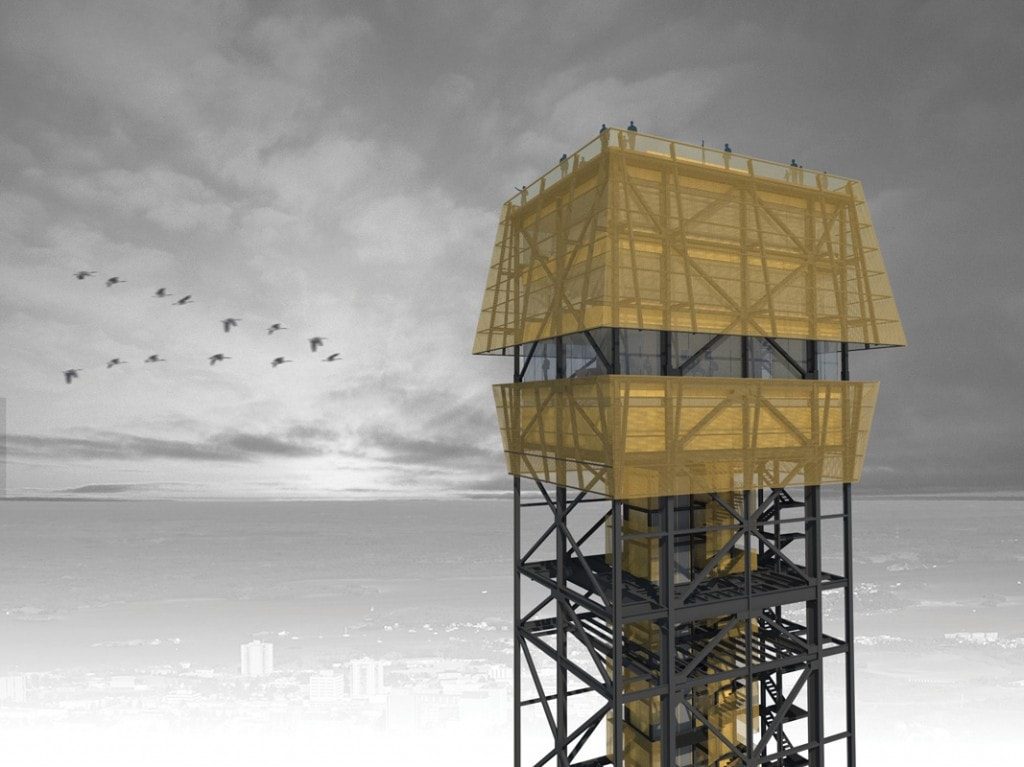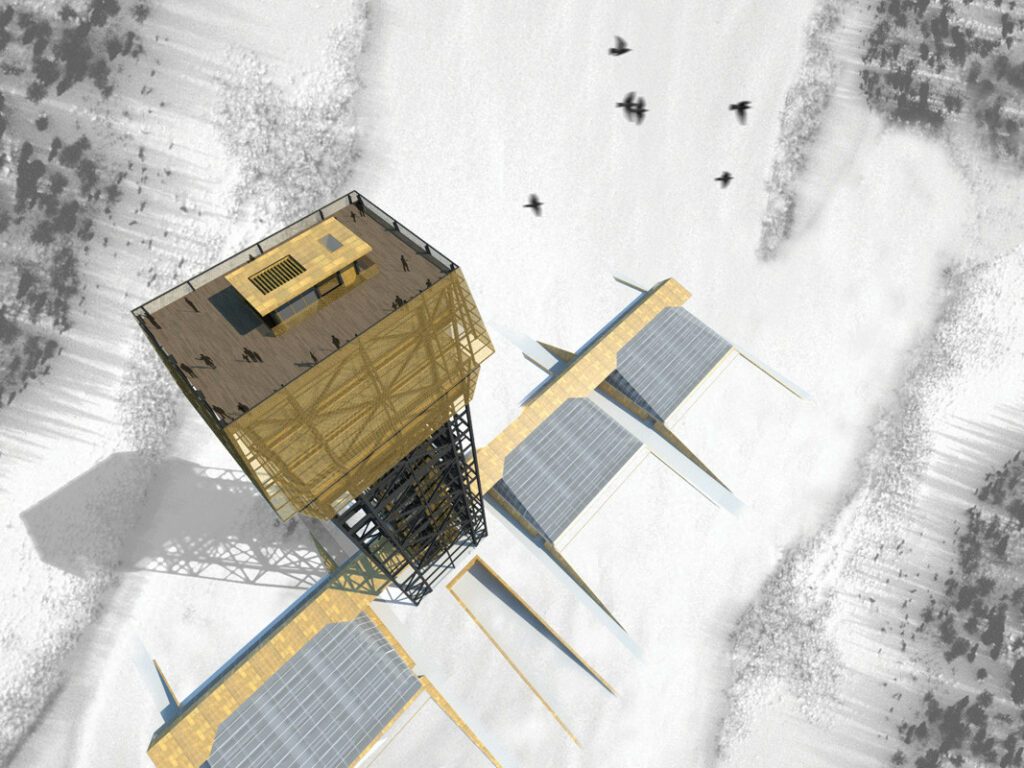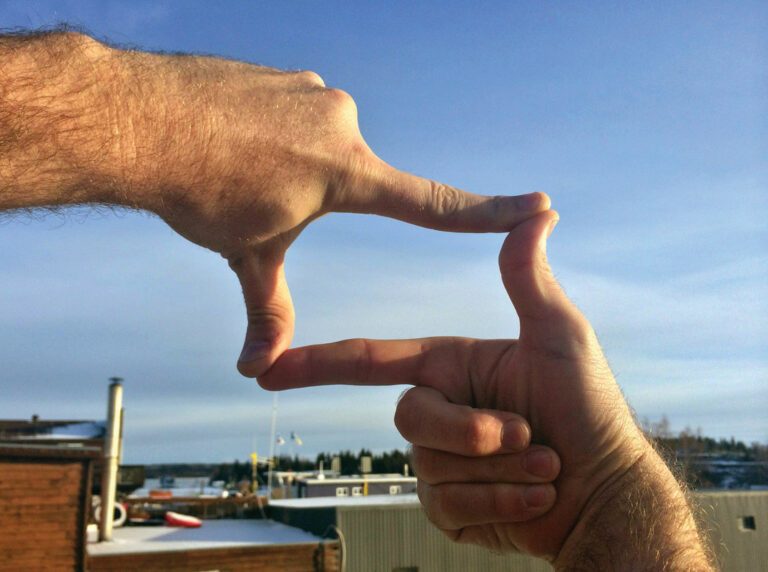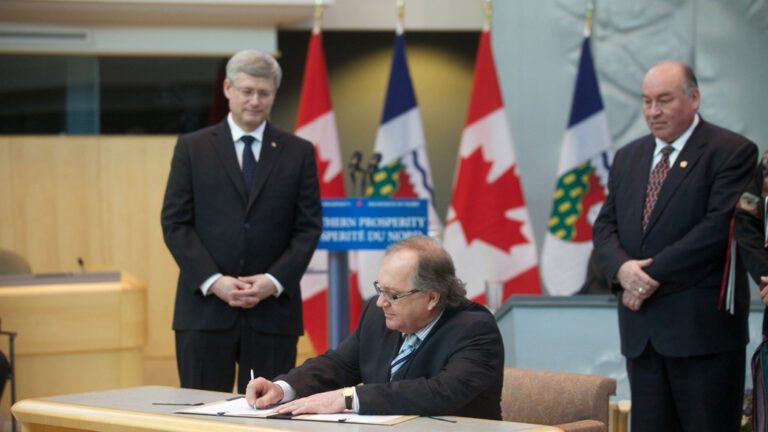From sustainable greenhouses to a privately funded business plan to take visitors to the top, here are just a few ways to keep the Robertson Headframe standing
Imagine the space the Robertson Headframe occupies suddenly void, a window on the stars. That’s probably how it would happen: the tallest structure ever built in the territory, likely the tallest that ever will be, listing, then toppling into a cloud of dust, to be cut up and bulldozed into tailings ponds and buried. You could sell tickets to that, and movie rights, too. That new version of the Yellowknife skyline could be coming as soon as this spring.
With the end of Con Mine remediation in sight, Newmont Mining Corp., is asking the City to decide the Robertson’s fate: take responsibility for it, or watch it fall. City Hall is looking into the details. Is the Robertson built to last 100 years? How would it be maintained? What will it cost to keep it? Who will pay? Will it be a static monument to an era when Yellowknife’s gold was paved with streets, a comforting landmark to travellers, a lookout, a climbing wall, a chimney for geo-thermal heat, or some other use that will contribute to its future?The last publicly estimated cost of deconstruction was around $1.2 million. It’s not clear how much of that Newmont would contribute to preserving the Robertson. Depending on the amount, it could leave the City $500,000 short. The mining industry and the federal government might be tapped for contributions, and there could be a direct appeal to the community through local crowd sourcing of the sort that’s traditionally financed small-town sports venues. Both of these options are doable – but do Yellowknifers have the will to make it happen? EDGE YK hopes they do.
Jobs, Decontamination and Vegetables
Why You Should Care about Saving Con’s Headframe

A ground level view of the proposed Robertson Headframe greenhouse complex.
artwork and story by Dave Stone
I first arrived in Yellowknife on a cold, dark afternoon in January 2011. Having driven from Halifax, I still recall the relief of pulling into the city after 6,000 km on the road. Driving up Franklin Avenue that day, I remember pointing out the distant silhouette of the Robertson Headframe to my shivering wife and declaring, “that must be downtown.” It turns out the Robertson Headframe wasn’t downtown, but little did I know, it would become the focus of my master’s thesis project a year later.
As the snow melted that spring, I became fascinated with the stark, barren landscapes that revealed themselves in the form of Giant and Con Mine. As an architect in training, I couldn’t help but imagine what could become of these vast, apocalyptic landscapes and their magnificent industrial buildings. Until then, I had always imagined these sites as being situated hundreds of kilometres from nearby cities, abandoned and forgotten once closed. But in Yellowknife, I discovered these properties and their buildings bound, characterize and symbolize a city that has evolved since their closure. After some inquiries around town, I soon discovered that most of these buildings were slated for destruction, and the properties would be more-or-less renaturalized. Ten to 20 years from now, young Yellowknifers would have no visual vestige of the city’s mining heritage: a legacy of prosperity, growth, and unfortunately, environmental degradation. Something has to be saved, and the monumental Robertson Headframe, in my opinion, is the most deserving candidate.
Newmont Mining Corporation was kind enough to give me a tour that summer, during which I experienced the impressive interior volume of the tower. Not often can you stand within a 25-storey windowless room. It was an impressive space indeed, particularly in a part of the world that is so predominantly flat. My initial feelings were confirmed, but what could become of such a building?
To begin, I am a firm proponent of adaptive reuse as opposed to static preservation. By fulfilling an everyday need for nearby Yellowknifers, a re-imagined Robertson Headframe could breathe new life into the Con Mine property, serving a functional purpose, yet respecting the history of the building and its original function. The question then became, “what could the Robertson Headframe contribute to the city of Yellowknife and its residents?” Located above an abundance of “free” geothermal heat, and towering over a scarred landscape in the midst of extensive remediation, the answer became increasingly clear. Wouldn’t it be poetic if a building that once extracted metal from the earth, could now contribute to its healing? By utilizing the abandoned mine’s excess heat and carbon dioxide, along with municipal compost and yard waste from nearby residents, the Robertson complex would make the perfect location for industrial greenhouses.

In order to keep the project financially feasible, only the top of the Robertson Headframe would be adapted for public use. Using similar projects in northern Europe as a reference, this portion of the Headframe could cost between $4-5 million to realize. Although the majority of the tower is stripped down to the magnificent steel frame, the upper level is wrapped in a perforated shiny metal skin, a subtle reference to the city’s namesake metal, and reminiscent of the tower’s old “red cap,” still functioning as a beacon to wandering boaters, pilots, and city dwellers alike.
These greenhouses could then be used to propagate plants known as “hyperaccumulators.” Once the ground thaws in spring, these plants can be transplanted into contaminated soil where they absorb vast quantities of arsenic in their foliage.
Months later, the plants can be harvested and the arsenic safely extracted for resale. Proven to cost significantly less than traditional clean-up efforts, this all-natural process, known as “phytoremediation,” could be an exciting possibility for the Con and Giant Mine properties. Although these greenhouses would be sheltered from cold winter winds at the base of the Robertson Headframe, the tower itself would contribute to the healing process in other ways. Firstly, the 25-storey headframe could draw hot air collected in the greenhouses upwards at a considerable velocity; enough to generate electricity by means of an internal wind turbine at the top of the tower’s central shaft, contributing significantly to the energy demands of artificial lighting.
Perhaps more importantly, the upper levels of the tower could provide a unique vantage point to the process of remediation occurring below. Similar lookout towers are common practice in countries like Germany, where governments encourage observation and community involvement during the process of land reclamation. An interpretation centre and lookout would build public awareness and environmental stewardship, fostering a sense of accountability and political transparency in the Yellowknife community. The interpretation centre could engage school groups, tourists and residents alike.
There are many reasons to re-imagine the Robertson Headframe: new employment opportunities; clean, carbon-free energy creation; the diversion of municipal organic waste, and the remediation of toxic waste at both Con and Giant mine. Best of all, once clean-up efforts are complete, the complex could be easily converted for agricultural use, providing fresh, arsenic-free produce for generations to come.

The expansive upper hoist room of the Robertson Headframe would be infilled with four levels of community space, plus an outdoor observation deck situated on the roof. The lower two levels consist of a café and restaurant with kitchen and mechanical space below. The upper two levels house an interpretation centre that showcases the history and ongoing progress of remediation efforts at the Con and Giant Mine properties. Exhibits and interactive displays could educate children, visitors, and citizens alike about the delicate balance between resource extraction and environmental stewardship in Canada’s sensitive northern ecosystem.
For more real estate stories, the city’s best rental board and property listings, visit Property North







